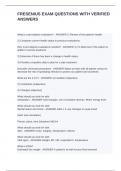FRESENIUS EXAM QUESTIONS WITH VERIFIED
ANSWERS
What is a pre-dialysis evaluation? - ANSWER-1) Review of the patient's health.
2) Compares current health status to previous evaluations.
Why is pre-dialysis evaluations needed? - ANSWER-1) To determine if the patient is
stable to receive treatment.
2) Determine if there has been a change in health status.
3) Provides a baseline date to plan for a safe treatment.
Describe Universal precautions - ANSWER-Steps we take with all patient contact to
decrease the risk of spreading infection to protect our patient and ourselves.
What are the 3 C's? - ANSWER-1) Condition (objective)
2) Complaints (subjective)
3) Changes (objective)
What should you look for with:
Ambulation - ANSWER-Gait changes, use of assistive devices, ROM, energy level.
What should you look for with:
Mental status and mood - ANSWER-A&O x 3, any changes in usual mood
(Alert and orientation)
Person, place, time (situation) A&Ox4
What should you look for with:
Skin - ANSWER-Color, integrity, temperature, edema
What should you look for with:
Vital signs - ANSWER-Weight, BP, HR, respiration's, temperature
What is EDW?
Estimated Dry weight - ANSWER-A patient's wt with excess fluid removed
,When is a RN required to assess a pre-treatment wt? - ANSWER-If the patient pre-
treatment wt is >4 kg above EDW.
What does a blood pressure measure? - ANSWER-Measurement of the pressure of
force of blood against the walls of the arteries.
When do you report a blood pressure to the RN? - ANSWER-SBP <100 or > 180
DBP> 100
When do you report a heart rate to a RN? - ANSWER-New onset of HR <60 or >100
or a irregular beat
When do you report a respiratory rate to the Rn? - ANSWER-A respiratory rate of > 24
breaths per minute
True or False
Does a dialysis patient maintain an average temperature? - ANSWER-False!
When do you report a temperature to the RN? - ANSWER-Temperature < 96 & > or = to
100 degrees
Name some important complaints you need to report to the RN?
(10) - ANSWER-1) Dizziness
2) Chest pain
3) SOB (shortness of breath)
4) Any new complaints
5) A visit to the ER or a hospital stay
6) Weakness
7) Numbness or tinglinng
8) Fever or chills
9) Depression/sadness
10) Pain
What changes do you report to the RN? - ANSWER-New medications or visit to ER or
hospital stay.
What are the ABC's of the patients assessment? - ANSWER-A) Access
B) Breathing
C) Cardiac
What to look for with:
Access - ANSWER-Bruises, redness, drainage, swelling, bruit, thrill, pain, bleeding
What to look for with:
Breathing - ANSWER-Rate, rhythm, quality, SOB, breath sounds
,What to look for with:
Cardiac - ANSWER-Skin color and turgor, heart sounds, pulse rate, rhythm & quality,
edema, pain, SOB
Why do patients expreience crackles (rales) breath sounds? - ANSWER-Indicates fluid
or congestion in lungs
Name some reasons for an abnormal heart rate? - ANSWER-Can indicate chemical
imbalances or adverse effects from medications.
Names some places fluid can get trapped?
(Edema) - ANSWER-Abdomen, lungs, feet, legs, hands,and face
What are the ranges for pitting edema? - ANSWER-1-4 cm
What do you do when you have a red light as a complaint? - ANSWER-Do not start the
treatment until the RN has done a full assessment on the patient.
Dialysis Prescription and Pre-treatment safety checks:
Name what verifies the correct patient's dialysis prescription?
(11) - ANSWER-1) patient Identity
2) prescribed dialyzer
3) prescribed dialysate
4) special attention orders
5) SVS or UF profiling
6) prescribed heparin dose
7) OLC volume/test entered
8) prescribed dialysate rate
9) prescribed base sodium
10) prescribed bicarbonate
11) prescribed needle size
Name important information programmed into the machine.
(6) - ANSWER-1) Prescribed treatment time
2) UF goal entered correctly
3) Prescribed BFR
4) Prescribed DFR
5) OLC volume
6) Na modeling or UF profile
Name the final dialysis machine safety checks.
(5) - ANSWER-1) Dialysate temperature
2) Dialysate pH & conductivity
3) NS doubled clamped
, 4) Alarm & pressure holding test passed
5) Final check on blood circuit
What is a priority and major reason why we monitor our patients? - ANSWER-Patient
safety
As fluid shifts during dialysis what changes can occur? - ANSWER-Blood pressure, fluid
and electrolyte shifts.
Who is responsible for monitoring patients? - ANSWER-Everyone!
The PCT must take what action when he or she identifies a potential problem? -
ANSWER-Immeddiate
The RN must respond to what from patients and the PCT? - ANSWER-Complaints or
PCT notifications to assess the patient
Why does a pateint's face and vascular access need to be visible at all times?
(3) - ANSWER-1) It is a CMS requirement
2) Identify any changes in the patient's awareness
3) A covered access can result in major blood loss
What are "Red Flags" to report to the RN?
(5) - ANSWER-1) Severe hypertesnion (SBP >200)
2) Severe hypotension (SBP <80)
3) New onset of pulse <60 or >100
4) Irregular heart rate
5) Temperature >or = to 100 degress
What should the RN do when notified about "red Flags" - ANSWER-1) Assess the
patient
2) Provide intervention
3) Report to the physician based on clinical judgment
Name 4 non-verbal behaviors that may indicate a change in the patient status or
discomfort: - ANSWER-1) Restlessness
2) Grimacing
3) Excessive yawning
4) Is patient alert, drowsy,sleepy
Name 5 changes you should educate your patient to report immediately? - ANSWER-1)
Discomfort at needle site
2) Muscle cramps
3) Headaches, dizziness, blurred vision
4) Nausea, vomiting
5) Fever, chills, chest pain, and SOB




